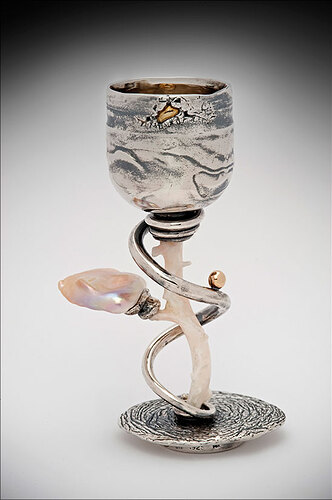Materials: Sterling silver, 18k gold, 14k gold, Pearl, Lapis Lazuli
Dimensions: 4" x 2" x 2.5"
By Dottie Joiner: " A spiral of forged silver wire wraps around the white coral stem of Swing Low Sweet Chariot Liqueur Cup(2010). Undulations on the diminutive chalice indicate clouds, and the gold that fills a ragged crack near the lip symbolizes a burst of sunlight. An irregular pearl projecting form the stem suggest the “pearly gates” of heaven, and a diminutive sphere of gold on the spiral refers to the wheels of the fiery chariot that descended in a whirlwind, taking up the prophet Ezekiel (2 Kings 2:11), Biblical source for the hymn from which the cup’s title is taken. On the underside of the base, a circle of lapis lazuli, whose hue refers to the heavens, is an emblem joining earth to shy. Mann’s cup brings to mind Jean Chevalier’s assessment of the chalice as a “vessel holding the draught of immortality”.’
Photo credit: walker montgomery
Barbara Mann
Watkinsville, USA
The objects I make tell a story, relate a concept or record an observation. The subjects that interest me seem to remain constant: nature, science theories or discoveries, history, the beauty of form, materials and detail. Currently, I have been investigating themes of life and death, health and disease and the area of transition between each of these dual realms. These subjects have a rich history to explore. My interpretations of various ideas and images allude to this history in art, science, religion and superstition.
These containers and vessels definitely hold their place in the world of stunning art objects as well as in the world of metalsmithing.
Since the dawn of time humans have created containers to hold things that were important to them, from large vessels to hold food and harvests to intimate containers for small precious things. They might hold memories, ashes, medicine, beverage, fruit or food - but all spring from the imagination and skill of the maker. Some have specific religious functions, some are meant for everyday use. When one thinks of a vessel or container the inclination is to think of something with solid walls - yet many of these works involve the exploration of positive and negative space, and the use of negative space to help create the illusion of the wall of the vessel.
As the world’s largest jewelry related internet site, Ganoksin strives to develop exhibitions showcasing work from around the world. This exhibition was open to all metalsmiths, professional and amateur, advanced and beginner. Participants are from The Netherlands, the USA, Canada, Australia, Costa Rica, the United Kingdom, Israel, Hong Kong, Colombia, Romania, Italy, Ireland, Japan, Malaysia and Denmark. While most of the pieces are by an individual metalsmith, some are collaborations, one of three artists spanning 50 years.
In total 319 artists contributed 729 show pieces for the permanent online exhibition.
Objects in the exhibition include boxes, lockets, urns, ash containers, bowls, wine cups, reliquaries, match holders, vases, teapots, pitchers, sugar bowls, baskets, nests, pillboxes, clutches and a range of sculptural forms. A variety of techniques are showcased covering a wide range of metalsmithing techniques. Materials used include everything from gold and silver to less expensive metals. Ornamentation includes the addition of enamel, chasing and repousse’, gemstones and found objects.
The exhibition was curated by Beth Wicker, President of the North Carolina Society of Goldsmiths in the United States, and Adjunct Instructor at Northeastern Technical College in South Carolina. Director of the exhibition is Hanuman Aspler, founder of The Ganoksin Project, the world’s largest internet jewelry site.
